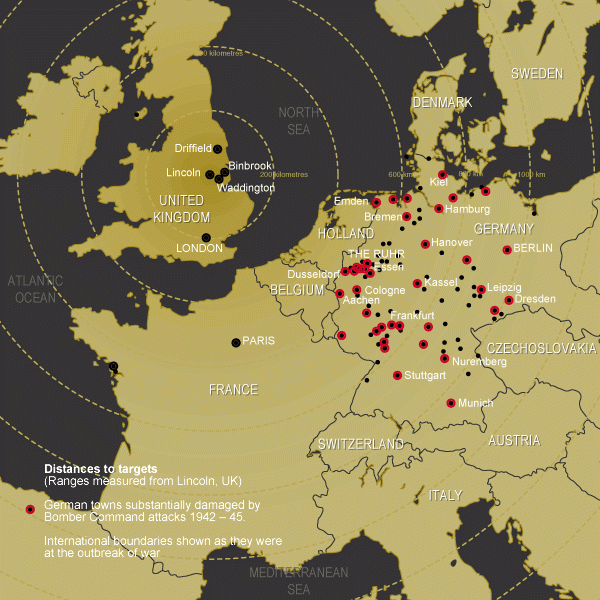Operations
Operations
The Battle of Berlin 1943/44
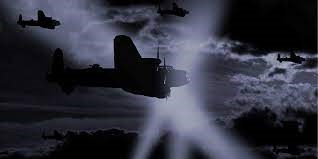
Lancasters in the bomber stream with enemy searchlights seeking them out
(Credit: Royal Air Force)
The Battle of Berlin 1943/44
The third of the sustained attacks on a single tactical target in 1943, the Battle of Berlin. It followed those mounted against the Ruhr (March – July) and Hamburg (July – August). After the Peenemunde raid on the German rocket development site, Fleet Street trumpeted “Berlin Next”. And so, it was.
From the outbreak of war, Berlin loomed large in the imagination of politicians, military planners and aircrew alike. Berlin was not just the political centre of the Third Reich. It was also an economic powerhouse. Its factories, administration and transport infrastructure were essential to Germany’s centralised industrial power base.
In the early years of the war, Berlin, at 590 miles (950 kilometres) from London, was at the extreme range attainable by the bombers then operated by the RAF. It could be bombed only at night in summer when the days were longer and skies clear—which increased the risk to Allied bombers.
The first RAF raid on the German capital took place on the night of 25 August 1940, with 95 aircraft targeting Tempelhof Airport, near the centre of Berlin, and Siemensstadt, home of the Siemens industrial company.
While the damage was slight, the impact on Germany was greater, both in terms of psychological impact and a commitment to invest heavily in air defences for Berlin at the expense of other weaponry.
Later in 1940 there were more raids on Berlin, but again these did limited damage. Raids grew more frequent in 1941 but were still largely ineffective in hitting important targets and losses were heavy.
During most of 1942, Bomber Command’s priority was attacking Germany’s U-boat ports as part of Britain’s effort to win the Battle of the Atlantic. In fact, during all of 1942 there were only nine air alerts in Berlin, none of them serious.
Only in 1943 did Air Chief Marshal Sir Arthur Harris, Air Officer Commanding-in-Chief, believe he had both the means and the opportunity to put his strategy of area bombing into practice. Now he could expect about 800 serviceable heavy bombers for each raid, equipped with new and sophisticated navigational devices such as H2S radar.
The strategy underlying the new offensive was that if the same destruction that had been previously inflicted upon Hamburg (see August newsletter) could be wrought on Berlin, it could lead to the surrender of Germany. Harris believed that “We can wreck Berlin from end to end if the USAAF come in with us.”
The German capital was, however, was a much more difficult target than Hamburg. The combination of size, geography and an extensive system of active and passive defences made Berlin the most dangerous target in Germany.
When the curtain covering a map of Europe at briefing was pulled aside to reveal the plan for an attack on the German capital – the Big City – more than the usual mixture of excitement, anxiety, even fair would sweep over the assembled airmen. Little wonder, for Berlin was ringed with a flak belt 40 miles wide and a searchlight band over 60 miles across.
Not only was Berlin well defended, but a large part of the route across Germany to the capital was also infested with anti-aircraft guns. Further, Berlin’s position made it relatively easy for the enemy to correctly predict that it was the target if the bombers were tracking in that direction. The defences could be prepared in readiness.
Perhaps, the greatest symbols of German resistance were the flak towers upon which the anti-aircraft guns were mounted. In one tower and U-Bahn (underground) station about 40,000 people could take refuge. More than mere defensive structures, these were built to demonstrate German defiance and technological superiority.
With their thick concrete walls, steel windows, kitchens, a hospital, air-conditioning and independent power and water supply, some residents claimed it was difficult even to hear the bombs during a raid – save for a direct hit. The only sign that a raid was in progress was that the ground shook slightly. The towers and air raid shelters were so sturdy that after the war many had to be built around.
Flying through the formidable flak defence, at least one aircrew described it was as though a “giant hand” took hold of the aircraft and shook it, like a huge dog shaking a rat.
The defences centred on twenty-four 128-mm anti-aircraft guns grouped in eight-gun batteries on massive flak towers. These were supported by a network of searchlights, and the use of decoy fires, decoy marker flares and decoy target indicators. Only the Ruhr region was more heavily defended.
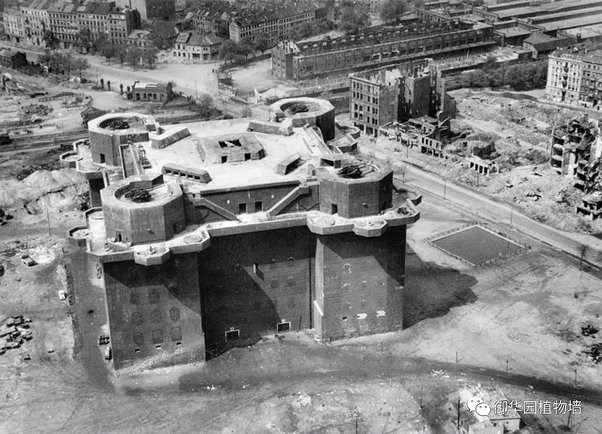
One of the massive flak towers in Berlin. (Credit: Royal Air Force)
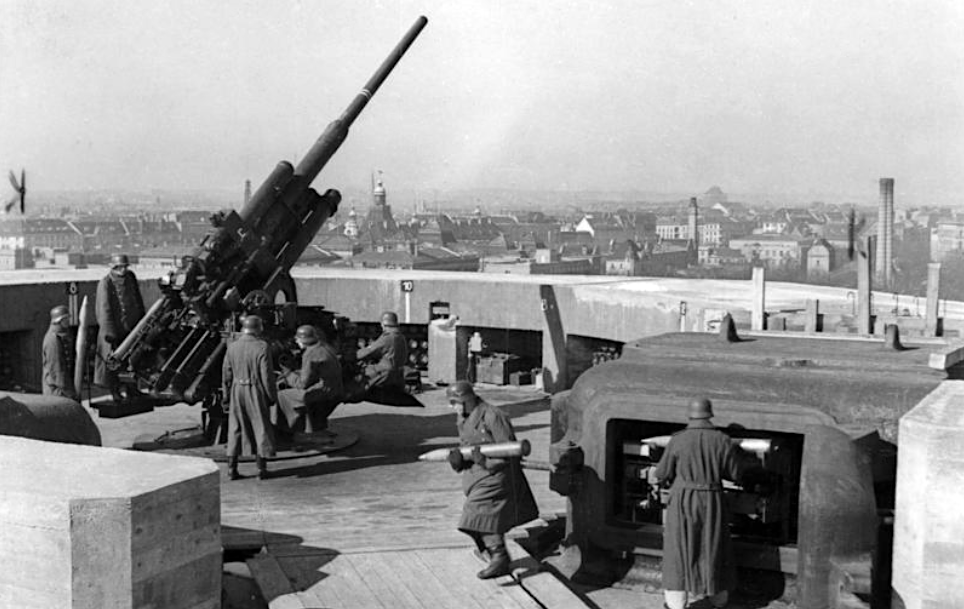
An anti-aircraft gun on top of a flak tower. (Credit: Royal Air Force)
The devastation of Hamburg in July had also meant that Luftwaffe chiefs were able to convince Hitler that fighter strength and all forms of air defence needed to be enhanced.
The Luftwaffe established a new system for their night-fighters. Instead of being confined to predetermined “boxes,” “wild boar” night-fighters patrolled above the target areas and waited for the attackers to come. It was a system which gave greater freedom and responsibility to some of the Luftwaffe’s most ambitious pilots.
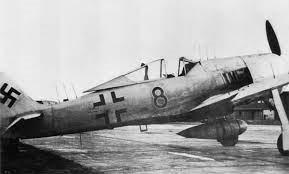
Focke-Wulf Fw 190A night fighter from II./JG300 with the FuG 217 “Neptun” radar
If cloud cover was heavy, rendering searchlights useless, the Germans released lanes of “fighter flares” above the bomber stream, to illuminate them for incoming defenders.
Although the longer hours of darkness during the winter nights helped protect the bombers, the predominantly cloudy winter weather created hazards for flying and meant it was difficult to see the target to bomb accurately.
The sheer size of the city brought its own challenges. With an area of more than 2,300 square kilometres, Berlin was Germany’s largest city and among the largest in the world.
When aircrew finally arrived over Berlin, they were stunned by the magnitude of the city itself. Crews felt like they were making “excruciatingly slow progress across it.” Target location was not helped by being outside the range of the more reliable Oboe radar network. Crews had to rely on onboard H2S radar, which, without a strong geographic feature such as a body of water, revealed only a very limited picture of the target area. The confusion of woodlands, lakes and smaller satellite towns around Berlin added to the difficulty of discerning the target areas.
The ambitious plan to relentlessly attack Berlin faced formidable opposition. And Harris’ plan was further setback when, unlike the earlier Battle of Hamburg, the USAAF, having recently lost many aircraft in attacks on Schweinfurt, did not participate.
The campaign consisted of a series of sixteen raids on the German capital, the first on the night of 23 August 1943 and the last on the night of 24 March 1944. The first three raids suffered a loss rate of almost 8 per cent and the offensive was postponed in early September to await the longer nights of winter, the installation of new electronic countermeasures and navigation aids, and the possibility of American attacks by day.
The offensive recommenced on the night of 18 November 1943 without much of the electronic equipment and without the hoped-for American support. Berlin was attacked by 440 Lancaster heavy bombers of the Main Force and four de Havilland Mosquitos, but the city was under cloud and the damage was not severe.
The second raid by the Main Force took place on the night of 22/23 November. This was the most effective raid on Berlin by the RAF of the war, causing extensive damage to the residential areas west of the centre, with several firestorms ignited because of dry weather.
Then on 17 December, extensive damage was done to the Berlin railway system. By this time the cumulative effect of the bombing campaign had made more than a quarter of Berlin’s living accommodation unusable.
There was another Main Force raid on the night of 28/29 January 1944, when the western and southern districts were hit in the most concentrated attack of this period.
On 15/16 February, important war industries were hit, including the large Siemensstadt area in the west, with the centre and south-western districts receiving most of the damage. This was the largest raid by the RAF on Berlin.
The campaign continued until March 1944. However, due to the effectiveness of German defences and continuing harsh weather, the offensive was not having the hoped-for effect.
With Bomber Command’s focus soon to be switched to preparatory raids for the Normandy invasion, the Berlin offensive was called off in late March 1944 with the final raid on the night of 24 March. Here the bomber force suffered 9 per cent casualties, with almost 400 airmen killed.
The campaign failed in its object of inflicting a decisive defeat on Germany. And the costs were exceedingly high. RAF Bomber Command flew 9,111 sorties against Berlin with the loss of 492 aircraft – mostly four-engine heavy bombers – and 954 damaged or written off, a loss rate of 5.8% (exceeding the 5% loss rate deemed sustainable by Bomber Command). More than 3,500 aircrew were killed or captured. For the men of RAF Bomber Command this was a particularly tough and dangerous period of the war.
The offensive killed some ten thousand Germans and destroyed 27 per cent of the built-up area of Berlin. The city, however, was not overwhelmed. Morale remained intact and civil infrastructure was quickly restored.
The Berlin offensive diverted German military resources from the Russian front and had an economic effect in physical damage, worker fatalities and injuries, relocation and fortification of industrial buildings and other infrastructure. Nonetheless, most historians agree that the campaign did not deliver the decisive blow that Harris expected.
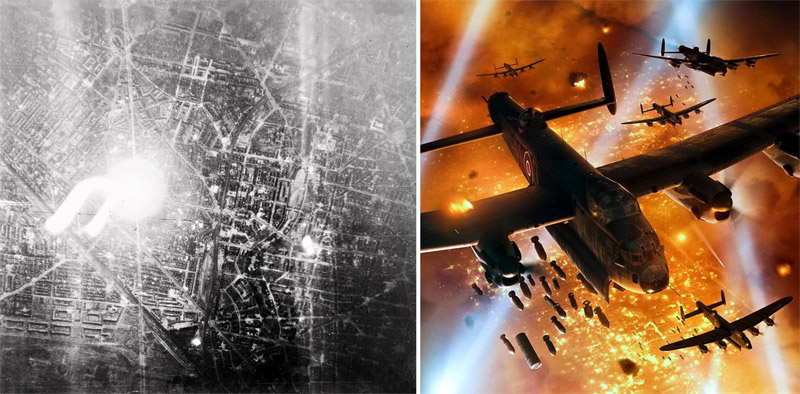
Left: Target Indicators (TIs) or markers fall on Berlin from a Pathfinder aircraft (Royal; Air Force).
Right: Artist’s impression of Lancasters bombing the ‘Big City.’ (Piotr Forkasiewicz).
New Zealanders who flew in the Battle of Berlin
As with the earlier strategic campaigns, New Zealand airmen were heavily represented in the Battle of Berlin. Of the sixteen raids, only five did not include New Zealanders. 66 New Zealanders lost their lives on the Berlin assault.
Vic Viggars (DFC), a wireless operator with 101 Sq., flying with fellow kiwi, Doug Todd, flew to Berlin eleven times in the campaign. He recalled that while crews never knew the target until briefing, they had a fair idea due to the fuel load ordered. Berlin was always a full load. In the briefing room, “If it was Berlin a murmur would go around the room.’ Crews knew the challenge ahead.
In addition to the usual bomb load, 101 Sq. was equipped with Airborne Cigar, special radio equipment designed to jam night-fighter communications. Their crews flew with an eighth man, a German speaker, who operated the extra radio equipment, in Viggars’ case an ex-Scotland Yard detective.
Sq. Ldr John Hegman (DSO, DFC) was killed on the second-last of the campaign’s raids. At 39 years of age, he is understood to be the oldest RNZAF pilot killed in WWII. He had enlisted in March 1942, under declaring his age by 12 years.
He had won the DSO on one of three Berlin raids in January. He found himself over Berlin ten minutes after the raid finished. Despite the flak batteries having a single target, somehow the bomb load was dropped, and they got away safely. His citation reads: ‘He is a gallant and skilful leader whose sterling qualities have impressed all.’
Allan Alexander’s crew of 75 Sq. had an eventful trip on 23-24 August. They shot down a Me 109 and then struggled through flak over Denmark on the return journey. Arriving at Mepal they had to circle due to an obstruction on the airfield. Running short of fuel, they were finally given permission to land but told to be extra careful – the obstruction was a stranded aircraft close to the runway, still loaded with bombs.
Of the 3583 Commonwealth graves in Berlin, eighty percent are of airmen. Fifty-six New Zealanders lie there. Bomber Command casualties were worst on the early raids of the campaign before Harris decided that Stirling losses were unacceptable and removed these from the roster.
Still equipped with Stirlings at the time, 75 (NZ) Squadron lost a total of nine aircraft on the three Berlin raids it participated on. Of the 64 aircrew aboard, only 10 survived to become POWs.
In addition to the aircraft shot down, many others were heavily damaged. Bill White’s Stirling was shot to pieces over the target yet somehow he made it back but with just half his crew. White’s logbook reads, ‘Badly shot up. Direct hit on rear turret. Rear gunner killed. Navigator, bomb aimer. W/Op bailed out. Crash landed at base. Awarded CGM (Conspicuous Gallantry Medal)’
75 Sq. Stirlings bombed Berlin for the last time on 22-23 November 1943. It was a massive raid, Harris ordering almost every unit into the air. Some 764 aircraft attacked the capital with 2500 tons of bombs causing significant devastation – including Hitler’s private luxury train that was destroyed.
The final operation of the campaign took the lives of almost 400 aircrew, with another 131 becoming POWs. Eight New Zealanders were killed on that last raid over the Big City, including John Mee.
Mee was a vastly experience Pathfinder pilot on his 45th op. He had completed a full tout with 75 Sq., before going straight to 7 Sq. without a break. He had been to Berlin twelve times; on that fatal night he was shot down with all crew lost.
